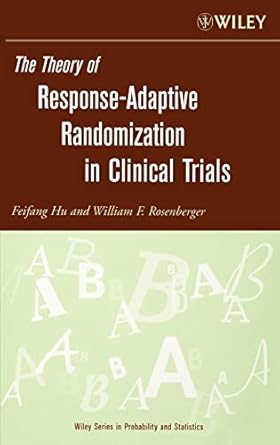
Download the free Kindle app and start reading Kindle books instantly on your smartphone, tablet, or computer - no Kindle device required.
Read instantly on your browser with Kindle for Web.
Using your mobile phone camera - scan the code below and download the Kindle app.

The Theory of Response-Adaptive Randomization in Clinical Trials 1st Edition
Purchase options and add-ons
The Theory of Response-Adaptive Randomization in Clinical Trials is the result of the authors' ten-year collaboration as well as their collaborations with other researchers in investigating the important questions regarding response-adaptive randomization in a rigorous mathematical framework. Response-adaptive allocation has a long history in biostatistics literature; however, largely due to the disastrous ECMO trial in the early 1980s, there is a general reluctance to use these procedures.
This timely book represents a mathematically rigorous subdiscipline of experimental design involving randomization and answers fundamental questions, including:
- How does response-adaptive randomization affect power?
- Can standard inferential tests be applied following response-adaptive randomization?
- What is the effect of delayed response?
- Which procedure is most appropriate and how can "most appropriate" be quantified?
- How can heterogeneity of the patient population be incorporated?
- Can response-adaptive randomization be performed with more than two treatments or with continuous responses?
The answers to these questions communicate a thorough understanding of the asymptotic properties of each procedure discussed, including asymptotic normality, consistency, and asymptotic variance of the induced allocation. Topical coverage includes:
- The relationship between power and response-adaptive randomization
- The general result for determining asymptotically best procedures
- Procedures based on urn models
- Procedures based on sequential estimation
- Implications for the practice of clinical trials
Useful for graduate students in mathematics, statistics, and biostatistics as well as researchers and industrial and academic biostatisticians, this book offers a rigorous treatment of the subject in order to find the optimal procedure to use in practice.
- ISBN-100471653969
- ISBN-13978-0471653967
- Edition1st
- PublisherWiley-Interscience
- Publication dateAugust 18, 2006
- LanguageEnglish
- Dimensions6.36 x 0.76 x 9.49 inches
- Print length232 pages
Editorial Reviews
Review
"I can recommend this book for the intended target audience which will include industry statisticians with a special interest in this area." (Pharmaceutical Statisitcs, 2008)
"…this ground-breaking text is certainly a useful guide and reference for the academic and industry statistician alike." (Journal of the American Statistical Association, December 2007)
“This book is useful for graduate students in mathematics, statistics and biostatistics as well as researchers and industrial and academic biostatisticians.” (Zentralblatt MATH, 2007)
"…a milestone in the literature on response-adaptive designs in clinical trials." (Biometrics, September 2007)
From the Inside Flap
The Theory of Response-Adaptive Randomization in Clinical Trials is the result of the authors' ten-year collaboration as well as their collaborations with other researchers in investigating the important questions regarding response-adaptive randomization in a rigorous mathematical framework. Response-adaptive allocation has a long history in biostatistics literature; however, largely due to the disastrous ECMO trial in the early 1980s, there is a general reluctance to use these procedures.
This timely book represents a mathematically rigorous subdiscipline of experimental design involving randomization and answers fundamental questions, including:
- How does response-adaptive randomization affect power?
- Can standard inferential tests be applied following response-adaptive randomization?
- What is the effect of delayed response?
- Which procedure is most appropriate and how can most appropriate be quantified?
- How can heterogeneity of the patient population be incorporated?
- Can response-adaptive randomization be performed with more than two treatments or with continuous responses?
The answers to these questions communicate a thorough understanding of the asymptotic properties of each procedure discussed, including asymptotic normality, consistency, and asymptotic variance of the induced allocation. Topical coverage includes:
- The relationship between power and response-adaptive randomization
- The general result for determining asymptotically best procedures
- Procedures based on urn models
- Procedures based on sequential estimation
- Implications for the practice of clinical trials
Useful for graduate students in mathematics, statistics, and biostatistics as well as researchers and industrial and academic biostatisticians, this book offers a rigorous treatment of the subject in order to find the optimal procedure to use in practice.
From the Back Cover
The Theory of Response-Adaptive Randomization in Clinical Trials is the result of the authors' ten-year collaboration as well as their collaborations with other researchers in investigating the important questions regarding response-adaptive randomization in a rigorous mathematical framework. Response-adaptive allocation has a long history in biostatistics literature; however, largely due to the disastrous ECMO trial in the early 1980s, there is a general reluctance to use these procedures.
This timely book represents a mathematically rigorous subdiscipline of experimental design involving randomization and answers fundamental questions, including:
- How does response-adaptive randomization affect power?
- Can standard inferential tests be applied following response-adaptive randomization?
- What is the effect of delayed response?
- Which procedure is most appropriate and how can "most appropriate" be quantified?
- How can heterogeneity of the patient population be incorporated?
- Can response-adaptive randomization be performed with more than two treatments or with continuous responses?
The answers to these questions communicate a thorough understanding of the asymptotic properties of each procedure discussed, including asymptotic normality, consistency, and asymptotic variance of the induced allocation. Topical coverage includes:
- The relationship between power and response-adaptive randomization
- The general result for determining asymptotically best procedures
- Procedures based on urn models
- Procedures based on sequential estimation
- Implications for the practice of clinical trials
Useful for graduate students in mathematics, statistics, and biostatistics as well as researchers and industrial and academic biostatisticians, this book offers a rigorous treatment of the subject in order to find the optimal procedure to use in practice.
About the Author
WILLIAM F. ROSENBERGER, PhD, is Professor and Chair of the Department of Applied and Engineering Statistics at George Mason University. He received the Association of American Publishers' Professional/Scholarly Publishing Award in 2002 for his coauthored work, Randomization in Clinical Trials: Theory And Practice (Wiley). A Fellow of the American Statistical Association, he has authored over fifty refereed articles and edited two monographs.
Product details
- Publisher : Wiley-Interscience; 1st edition (August 18, 2006)
- Language : English
- Hardcover : 232 pages
- ISBN-10 : 0471653969
- ISBN-13 : 978-0471653967
- Item Weight : 1.03 pounds
- Dimensions : 6.36 x 0.76 x 9.49 inches
- Best Sellers Rank: #8,048,987 in Books (See Top 100 in Books)
- #8,719 in Statistics (Books)
- #15,970 in Probability & Statistics (Books)
- #432,595 in Unknown
- Customer Reviews:
About the author

Discover more of the author’s books, see similar authors, read author blogs and more
Customer reviews
- 5 star4 star3 star2 star1 star5 star0%100%0%0%0%0%
- 5 star4 star3 star2 star1 star4 star0%100%0%0%0%100%
- 5 star4 star3 star2 star1 star3 star0%100%0%0%0%0%
- 5 star4 star3 star2 star1 star2 star0%100%0%0%0%0%
- 5 star4 star3 star2 star1 star1 star0%100%0%0%0%0%
Customer Reviews, including Product Star Ratings help customers to learn more about the product and decide whether it is the right product for them.
To calculate the overall star rating and percentage breakdown by star, we don’t use a simple average. Instead, our system considers things like how recent a review is and if the reviewer bought the item on Amazon. It also analyzed reviews to verify trustworthiness.
Learn more how customers reviews work on Amazon-
Top reviews
Top review from the United States
There was a problem filtering reviews right now. Please try again later.
The most common and most frequently taught approach to statistical inference is the frequentist approach. In the frequentist approach the observed sample is viewed as though it were independently drawn from a population with a specific but unknown probability distribution associated with it. In most courses this construct for the data is taken for granted, However it does have practical limitations. A rare attribute of this book is that it points out the practical limitations and sometimes artificial nature of the frequentist approach. These authors take a completely different approach to statistical inference which may be called the randomization approach. This approach may fall under the category of Fisherian inference that was the method of inference developed by R. A. Fisher at the same time as Neyman and Pearson were developing hypothesis testing and confidence intervals based on a frequentist approach.
The advantage of the authors' approach is that they do not need the concepts of sample space and repeated sampling to construct an probabilistic model for inference. Instead their model is based on the data being a reference set that is compared to other outcomes that could have arisen had the observations been permuted to mix up the allocation of the observed values among the treatment groups. So the inference is based on a permutation distribution that is valid under the null hypothesis that there is no difference between the observations in the two groups. If there were a difference the observed statistic would fall in one of the extreme tails of the permutation distribution.
In practice what is necessary to make this work is to have a well-defined randomization procedure for the allocation of the subjects to the treatment groups. This is typically done in phase III pharmaceutical trials where the FDA usually requires a randomized controlled clinical trial to establish the safety and efficacy of a new treatment.
Although this approach seems less restrictive then the frequentist approach and can also be used in observational studies where the frquentist approach breaks down, it requires the reader to know or learn a new statistical paradigm which technically draws a different kind of conclusion than the standard frequentist approach has to hypothesis testing and interval estimation of parameters.




